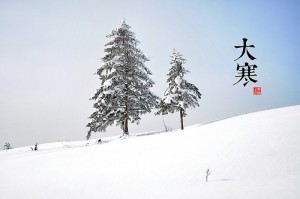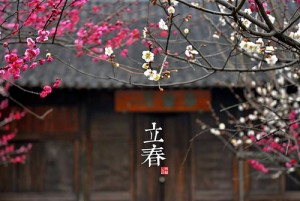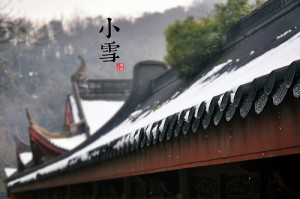
Contributor: As another New Year begins, it’s interesting to consider the traditional Chinese solar calendar, which featured 24 mini-seasons closely tied to what was happening in the natural world. These 24 solar terms helped farmers remember their way through nature’s growing cycles.
This sounded like a topic we had to explore further at Seasonal Wisdom, so we asked Ann Bingley Gallops of NY-based Open Spaces Feng Shui to provide a quick overview of these fascinating 24 solar terms that make up the Chinese solar calendar. It’s little wonder why these nature-oriented calendar terms still ring true to us today. Come take a peek. All photos courtesy of Jeriff Cheng on Flickr.
Seasonal Wisdom readers may remember these helpful winter, spring, summer and fall Feng Shui tips for your home from Ann Bingley Gallops of NY-based Open Spaces Feng Shui.
Here’s what she had to say about the 24 solar terms in the traditional Chinese solar calendar:
As a Feng Shui consultant I am exposed to many fascinating aspects of ancient Chinese culture and how these ideas can benefit us in the world today.
A primary concern that drove the foundation of Feng Shui and many other East Asian concepts was the need for farmers to protect their crops under challenging circumstances ranging from armed attacks to a vague understanding of when to plant and harvest crops.

Feng Shui branched off to create ideas such as the Commanding Position, helping farmers decide on the best locations to place their farms for safety and abundant growth.
The crucial need to know how to manage their farms for the greatest health and profit caused them to invent an annual calendar called the Solar Term, in which the year is divided into 24 narrowly-defined “seasons,” which told farmers what to expect from the climate as the year went by.
The divisions were created using the traditional Chinese solar calendar, according to the point at which the sun reaches 24 equally-spaced points along the ecliptic longitude.
Many, many centuries later, these 24 seasons still have relevance today.

Some of the seasons define annual solar events, such as the Spring and Fall Equinoxes and Summer and Winter Solstices.
Others have wonderfully evocative names that embody the wonders of the changing year such as Waking of the Insects (March 5), Slight Heat (July 7), Heavy Snow (December 7) and so on.
I find myself musing on these mini-seasons as each year goes by and hope you will enjoy knowing about them too.
Here are the 24 Solar Terms of the traditional Chinese Solar Calendar:
- Spring Begins ———-Feb. 2-5
- The Rains ——————Feb. 18-19
- Insects Awaken ———–March 5-6
- Vernal Equinox———–March 21
- Clear and Bright ———-April 5
- Grain Rain —————–April 21-22
- Summer Begins ——-May5-6
- Grain Buds —————-May 21-22
- Grain in Ear —————June 5
- Summer Solstice ———June 21-22
- Slight Heat —————-July 7-8
- Great Heat —————-July 23-24
- Autumn Begins ——Aug 8-9
- Stopping the Heat ——-Aug 23
- White Dews —————Sept. 7
- Autumn Equinox——–Sept 22-23
- Cold Dews —————-Oct 8-9
- Hoar-Frost Falls———Oct 23
- Winter Begins ——–Nov 7-8
- Light Snow —————Nov 22-23
- Heavy Snow ————-Dec 7-8
- Winter Solstice ———-Dec 21-23
- Slight Cold —————Jan 5-7
- Great Cold —————Jan 20
Source: People’s Daily Online
All photos courtesy of Jeriff Cheng on Flickr, who documents the different 24 seasons beautifully throughout the year.
Ann Bingley Gallops, owner of Open Spaces Feng Shui in Brooklyn New York, is an expert Feng Shui consultant, blogger and speaker. A Feng Shui consultation with Ann helps you get unstuck, create a positive environment where you can blossom and thrive, and attract abundance in every part of your life.
Ann is the author of Map Your Space To Change Your Life: A Guide To The Feng Shui Bagua. She practices Feng Shui with an MBA from Columbia University, a Practitioner’s Certificate from the Western School of Feng Shui, and Red Ribbon Professional membership in the International Feng Shui Guild.
Follow Ann on Facebook, Twitter and Pinterest, and on the Open Spaces Feng Shui blog.













{ 14 comments }
Thanks Ann for enlightening me on the Chinese solar calendar. I’m all set for the Slight Cold and Great Cold
Thanks for stopping by, Sean. I’m rather psyched about “Clear and Bright” myself. Happy new year! Teresa
Very interesting! I’d never heard of the Chinese 24 mini-seasons. It’s amazing how in-tuned these farmers were with the natural world!
Kerry: Thanks for your comment. It makes sense why the Chinese farmers were so closely tied to nature. I’m also amazed how similar this Chinese traditional calendar were with the old agricultural calendars of Europe in past centuries. That’s why “midwinter” was the old name for the winter solstice. Hope to see you again. Teresa
Thanks Sean and Kerry! I’m looking forward to the Awakening of the Insects, myself ;))
Ann: Always delighted to have a guest post written by you! Happy new year. Teresa
That was one of the most interesting articles I’ve read in awhile. Thanks for posting that!
Lisa, I’m so glad that you enjoyed that article. Hope to see you back at Seasonal Wisdom again. Happy new year! Teresa
Lisa, it’s rich stuff, I agree, and adds a lot of dimension to the passing of the year. I’m so happy you found the article interesting!
Very interesting share for New Years Day. I love thinking of it has 24 new gardening seasons! 😉
Me too, Bren. And I love how closely linked this Chinese traditional calendar was with Europe’s traditional agricultural calendar. Happy new year! Teresa
Bren, I’m so happy you enjoyed the article! I love the idea of 24 gardening seasons 😉
Thank you so much for sharing the link, Therese. As a Feng Shui practitioner I love this calendar because it creates a greater sense of the harmonies of nature, helping us to stay balanced in our bodies and our minds throughout the year.
Thank you for sharing this little piece of the Chinese Calendar. The Ming Li Tong Shu, the Chinese solar, lunar, and etc, Calendar, is available online in English at (I’m not associated with this site):
http://www.tongshu.com/ts.jsp
It’s free to access the current day. Practitioners of Traditional Chinese Medicine, of which Feng Shui is one of the eight branches, use this calendar daily for everything from planning activities in tune with nature, to choosing “open” acupuncture points. It’s a rich and fascinating nature based subject!
Nice to meet you, Therese. We appreciate your providing more information on this fascinating topic. Hope to see you again at Seasonal Wisdom. Teresa
Comments on this entry are closed.
{ 1 trackback }